After their relegation from the Premier League, Norwich City are preparing for life back in the second tier of English football. The Canaries have wasted no time in bringing new players to aid what they hope will be a promotion push. Sporting Director Stuart Webber has brought seven players into the club already since the transfer window opened, and all of those new recruits are aged between 18 and 23. It’s clear to see this is a club who have a long-term strategy in mind, and, although they are a newly-relegated club, it’s unlikely that there will be much pressure on manager Daniel Farke to lead Norwich back to the Premier League at the first time of asking.
One of their new recruits is Polish winger Przemyslaw Placheta. The 22-year-old swapped his native country for East Anglia, joining the Canaries on a four-year deal from Slask Wroclaw. In this scout report, we’ll provide a tactical analysis of Placheta’s game and evaluate what he’ll bring to the Championship side.
Overview
Although Placheta is by no means at his peak, expect him to feature a fair bit in the Championship next season. In the Ekstraklasa, the former Polish youth international played a total of 3,208 minutes. He scored eight times and directly set up three goals. Placheta is primarily a left-footed left-winger, but, due to his tendency to drift infield and combine with teammates, he’s capable of playing off the right flank as well.
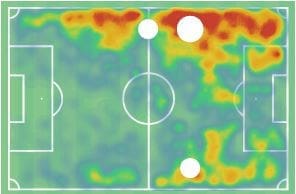
As you can see from his heat map, Placheta’s starting position tends to be on the left channel, but he likes drifting infield into the half-space and into the centre. He’s also played plenty of football on the right side, often switching flanks with his opposite winger to keep opposing defenders guessing. His ability to switch wings and drift infield fitted well into Slask Wroclaw’s tactics. They often played a 4-2-3-1 formation, with an emphasis on the front four rotating positions.
Pace
One of the most eye-catching aspects of Placheta’s game is his electric pace. Known as the fastest player in the Polish top tier last season, the 22-year-old reportedly once ran 30 metres in 3.8 seconds. Therefore, Placheta, who spent time at the academy of Bundesliga side RB Leipzig as a teenager, can certainly be a threat against teams who play a high line. In the image below, his former club Slask Wroclaw held a 2-1 lead. As their opponents Cracovia chased an equaliser, space really started to open up for him in behind. From a route one goal kick, striker Erik Esposito went up to win the header, dragging the central defender out of the defensive line. Placheta saw an opportunity to gamble on the flick on and run in behind the high defensive line.
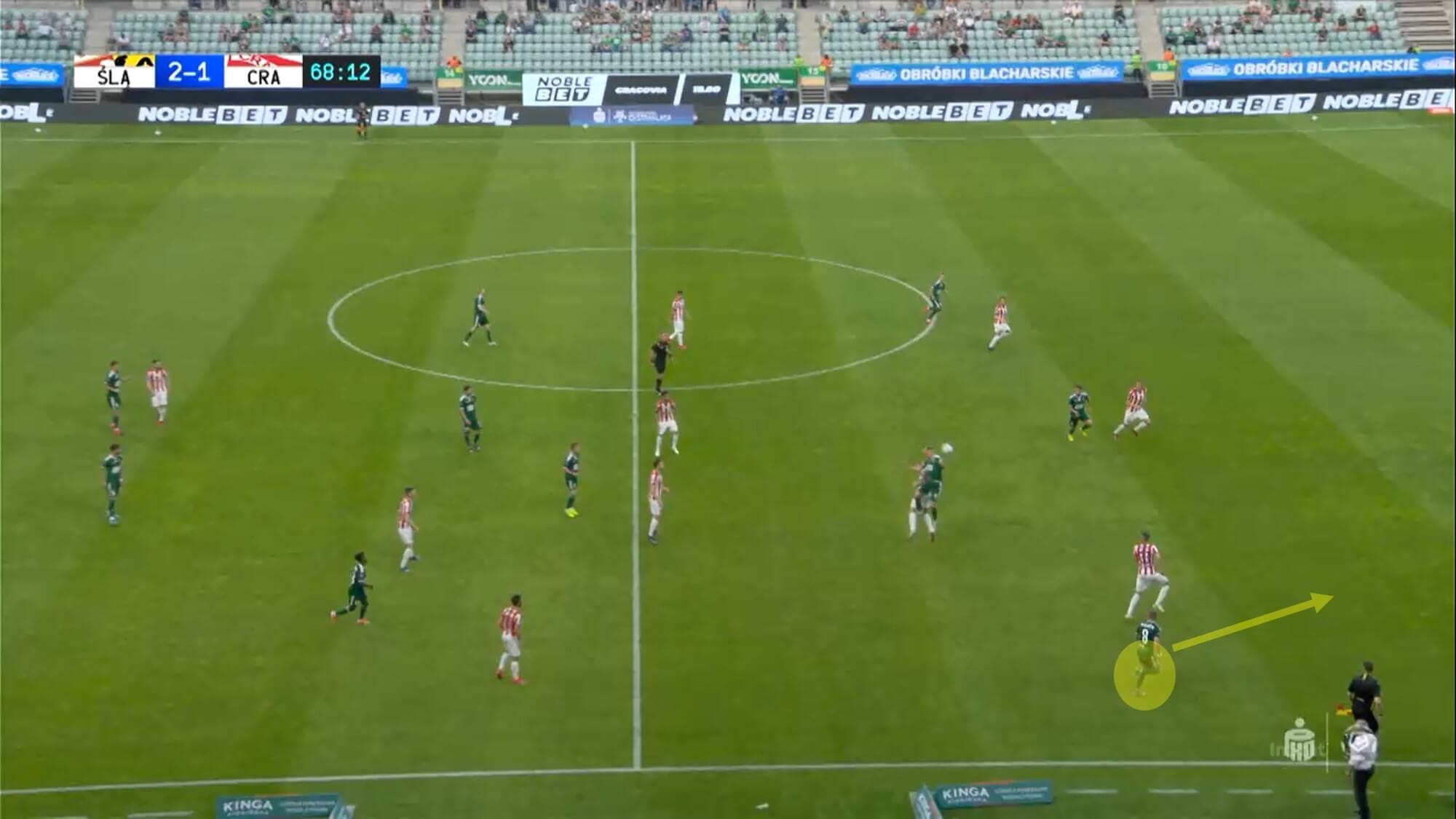
After that, he’s away. When there is an opportunity for a fast break, Placheta is quite direct and single-minded. He’s capable of a trick but he doesn’t rely on fancy flicks to get past opposing defenders, instead possessing that burst of pace to charge forward. Generally, he’ll aim to get to the byline and pull the ball back across the face of goal to a teammate. Using his pace, this is the area he manages to get into on the image below.
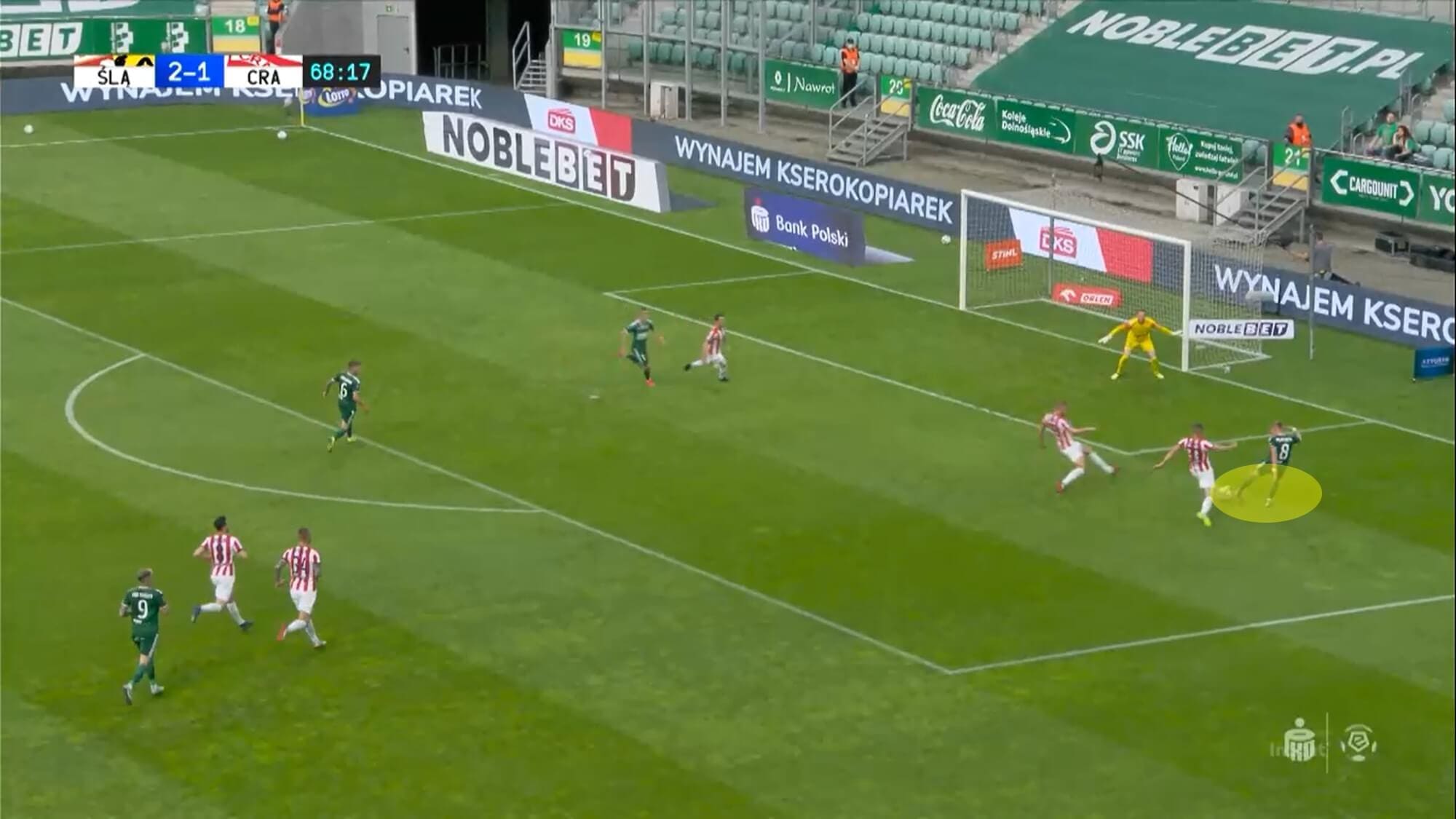
On this occasion, he doesn’t get his end product quite right. We’ll focus on that more later in the analysis.
Off the ball movement
But how will he fare when teams employ a low or mid-block against Norwich? As they’re likely to be one of the better teams in the division who seek to play on the front foot, teams may sit deeper and deny them space in behind. City fans will be pleased to know that Placheta isn’t purely a speed merchant. He combines that electrifying pace with genuine clever movement out of possession.
When his team have the ball, the former Polish youth international is always thinking about how he can create space for either himself or his teammates. A lot of these movements involve him roaming into the half-space, and between the lines of the opposition defence and midfield. He’d often come central and temporarily play as a number ten, as Slask Wroclaw aimed to create numerical superiority in that area. Placheta doesn’t only play on the left-hand side, but he’s also capable of rotating with both of his teammates in the attacking midfield three.
This makes it harder for opponents to pick them up in a man-orientated defensive structure, because they’re more likely to get pulled out of position. The two graphics below show his deliveries into the penalty area, and his dribbles in the final third. Note how many of them come from central positions and on the right hand side, despite him playing predominantly on the left flank.
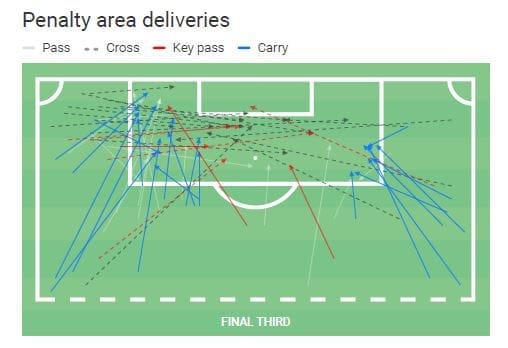
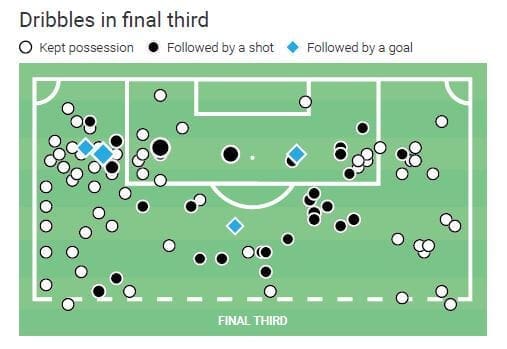
In the image below, Placheta started in a more advanced position between the lines, but he drops deeper towards the man in possession.
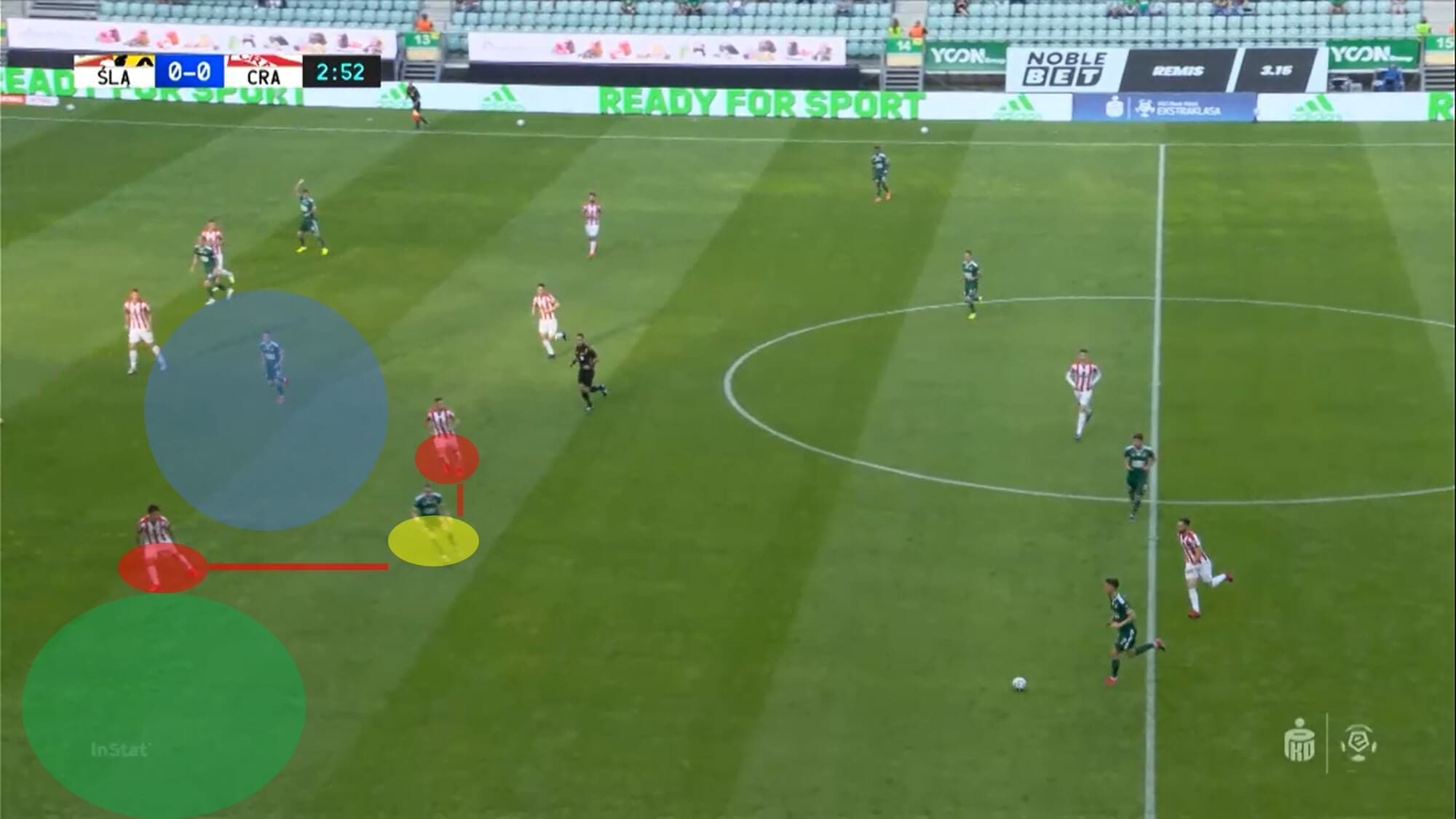
He stays in between KS Cracovia’s right winger and right-sided central midfielder, creating a decisional problem for them. If one of them gets tight to him, they’d be vacating space which could be exploited. But the main point of what he does here is that he creates space for the attacking midfielder, as he dragged the two midfielders near him closer to the ball. This meant that the space between the opposition’s midfield line and defensive line became larger, resulting in the attacking midfielder having more space to operate in (represented by the blue circle).
Also, his positioning in the half-space drags the left-sided midfielder inside, creating more space on the left channel for the Slask left-back to advance into (represented by the green circle).
A clever way that Placheta creates space for himself is through performing double movements. In the image below, it looks like he’s going to try and run in behind the opposition defence. Knowing the pace that he has, this causes the central defenders to drop off.
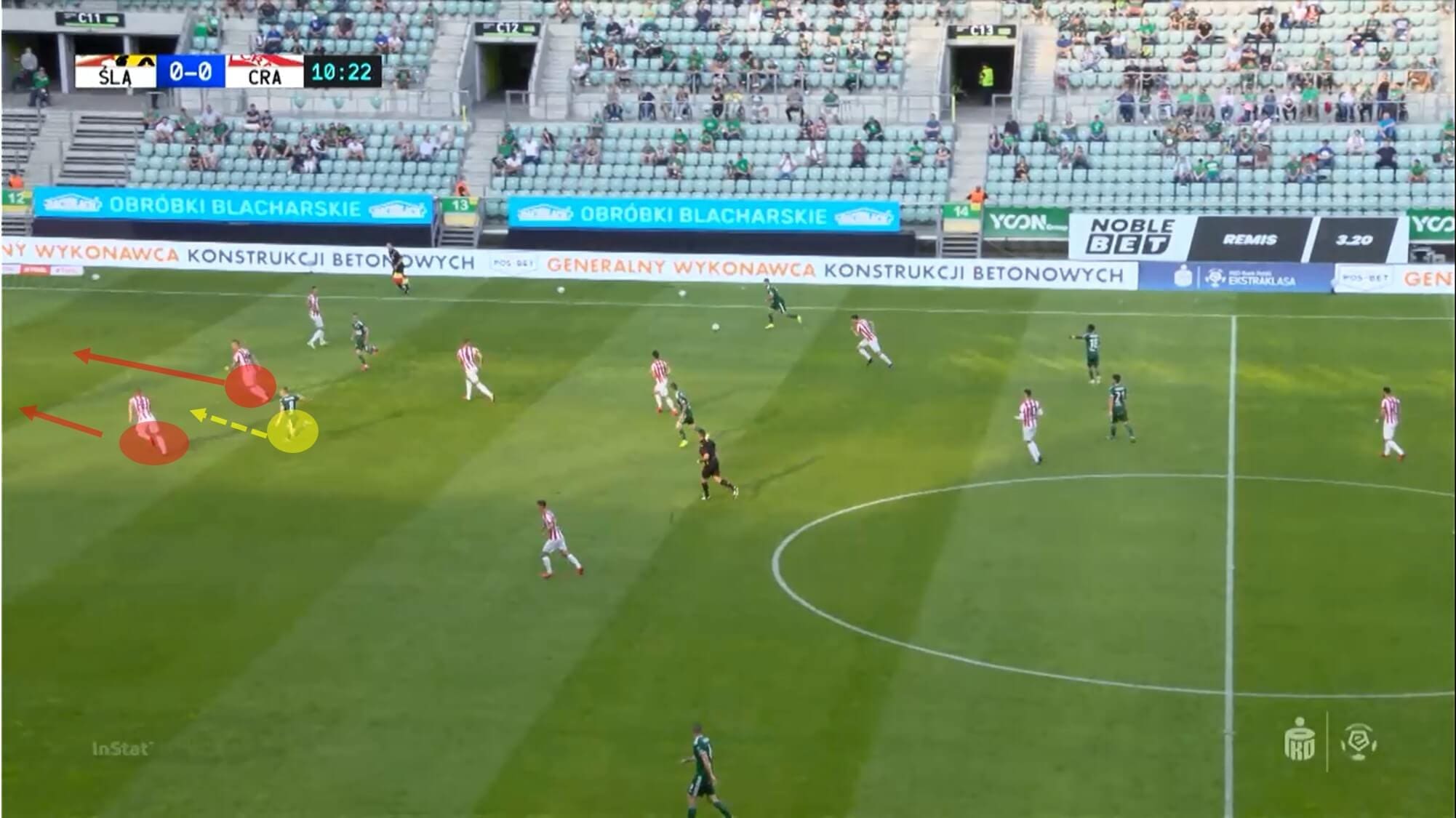
As the defenders retreated towards their goal, the youngster dropped off in between the lines. By feigning to run in behind, he created an extra few yards of space for himself and his teammates to operate in. He’s then joined by two of his teammates, who form a triangular shape between the Cracovia defence and midfield.
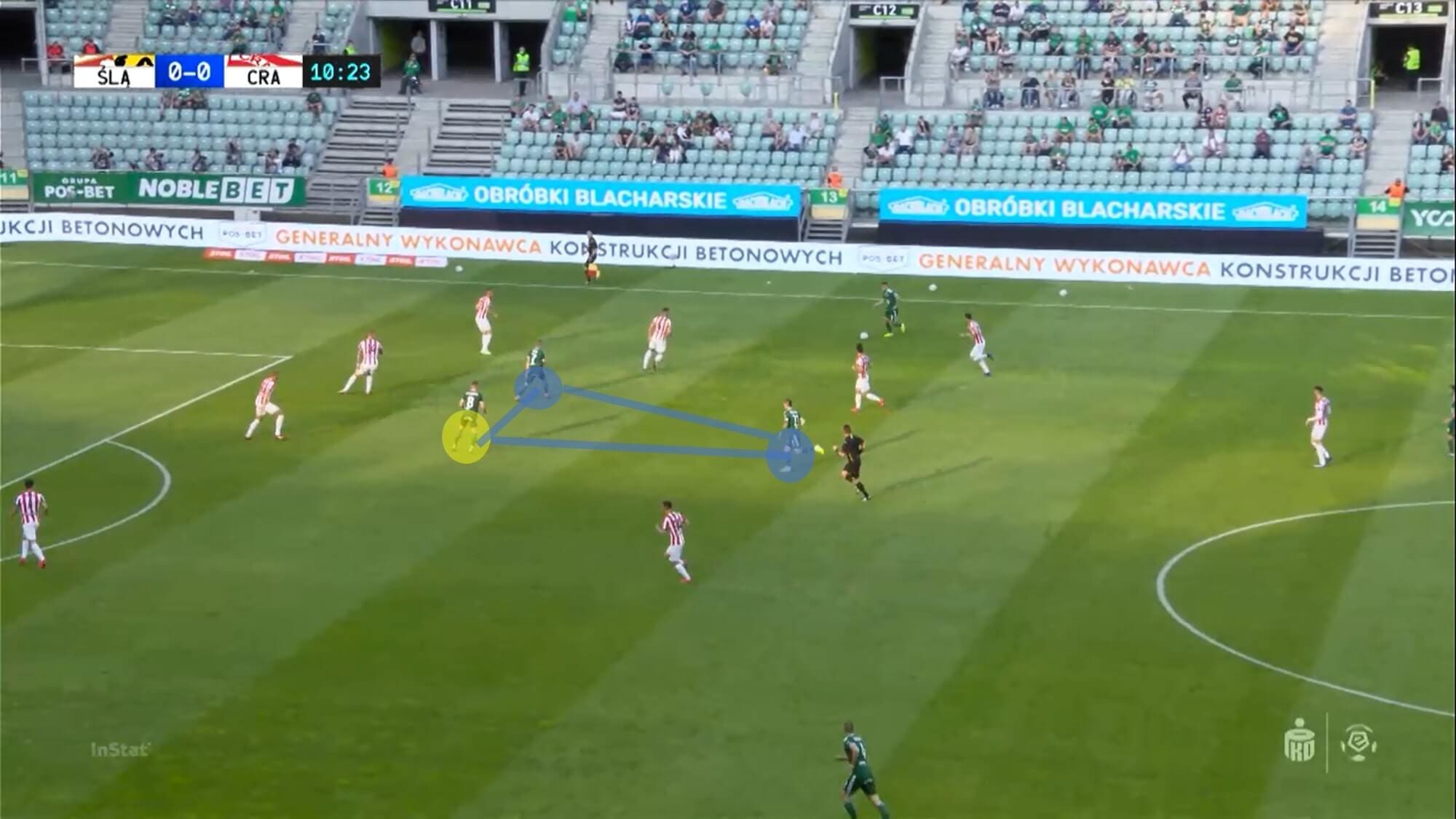
That’s a very promising attacking situation to be in, because the player in possession between the lines could draw out one of the defenders who would want to apply pressure to the ball. By doing this, they’d vacate the space in behind them, and Slask could potentially have two players to run in behind. Norwich were excellent at scoring these types of goals in their 2018-19 Championship promotion season.
Creativity and end product
So we’ve looked extensively at how good Placheta is off the ball, but what’s he like in possession? Well, his end product is fairly mixed, and it’s something that Daniel Farke will be keen to work on. Last season, he averaged 3.39 crosses per 90 minutes, with an overall accuracy of 28.93%. That success rate was towards the lower end of the scores, out of all wingers in the Polish top tier last term.
In the image below, he’s managed to work his way to the byline in trademark fashion.
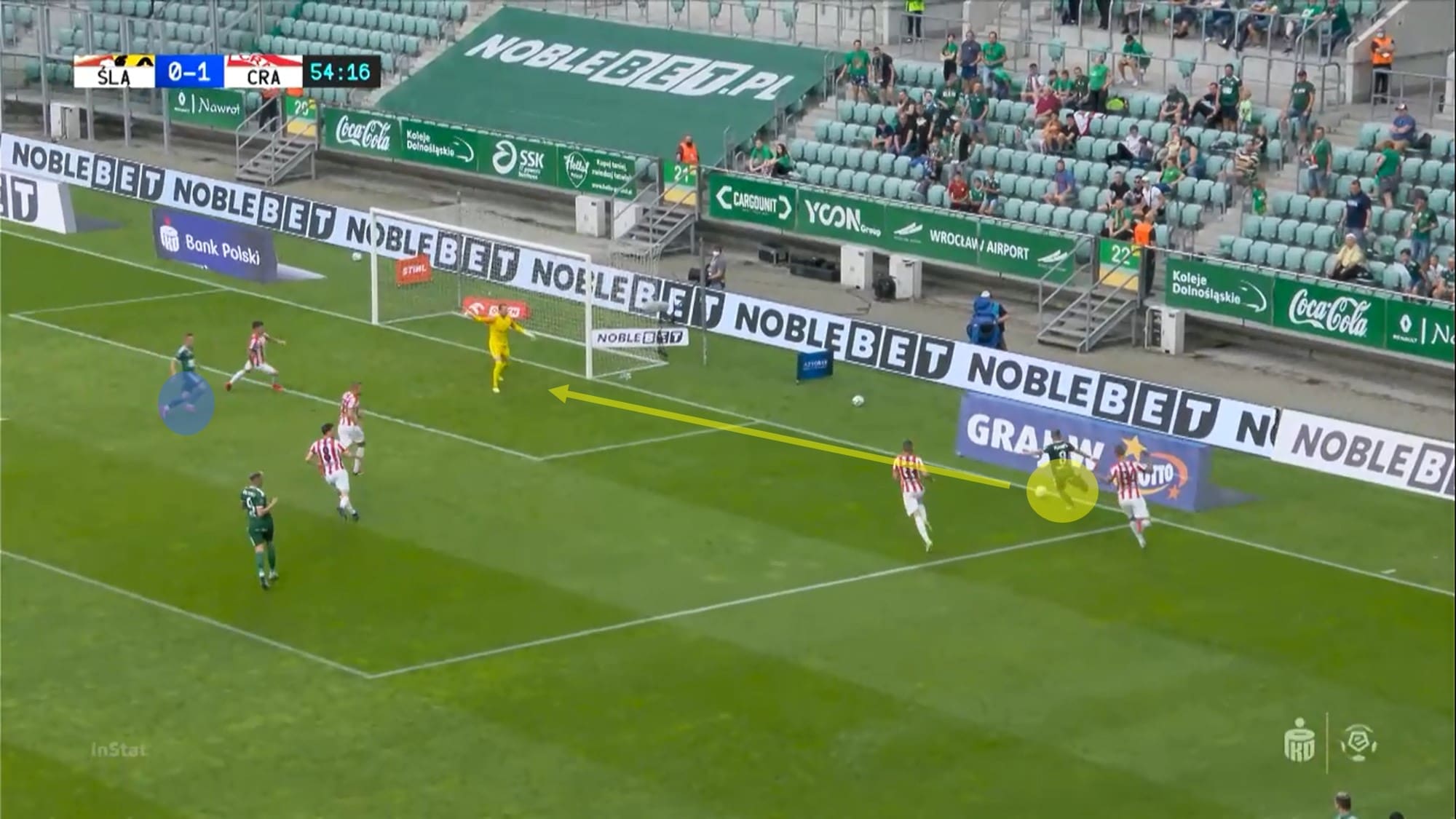
With his teammate in a good position, he just needed to pull it back to the edge of the six-yard box and hope that he managed to get on the end of it. However, he plays a tame ball straight into the goalkeeper’s hands.
His decision making sometimes lets him down in the final third. Placheta travels at such a high speed, so it’s understandable that, on occasions, he makes the wrong choices in possession. In the image below, he opts to play a pass into the striker. However, he should have played the ball out wide, as his two teammates would have had a 2v1 numerical advantage on the opposing winger.
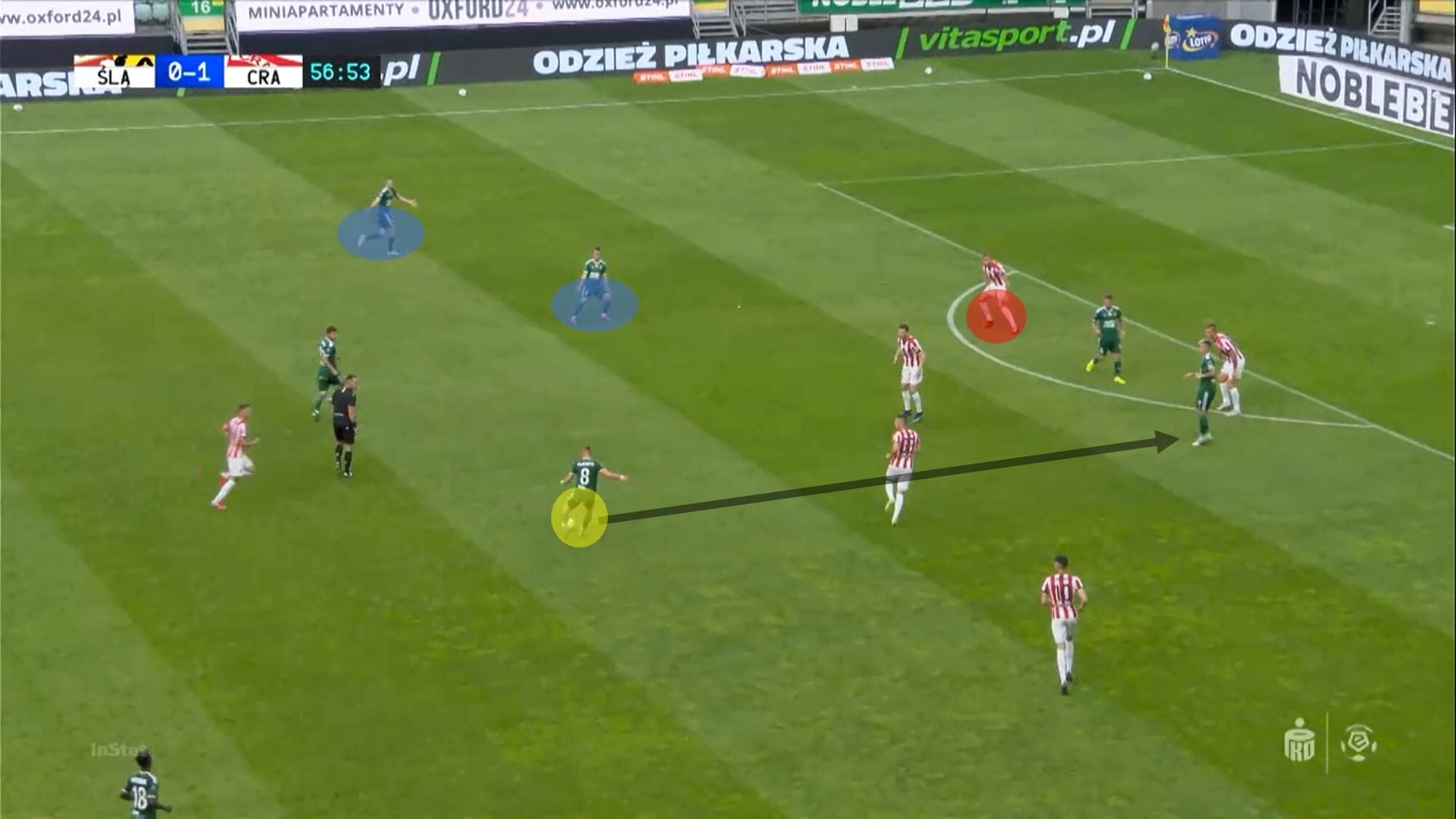
In terms of his creativity, Placheta is a capable dribbler, but he also looks to combine cleverly with his teammates to progress the ball into dangerous areas. In the image below, he recognises that Slask’s attacking midfielder has dropped a yard deeper to become a passing option.
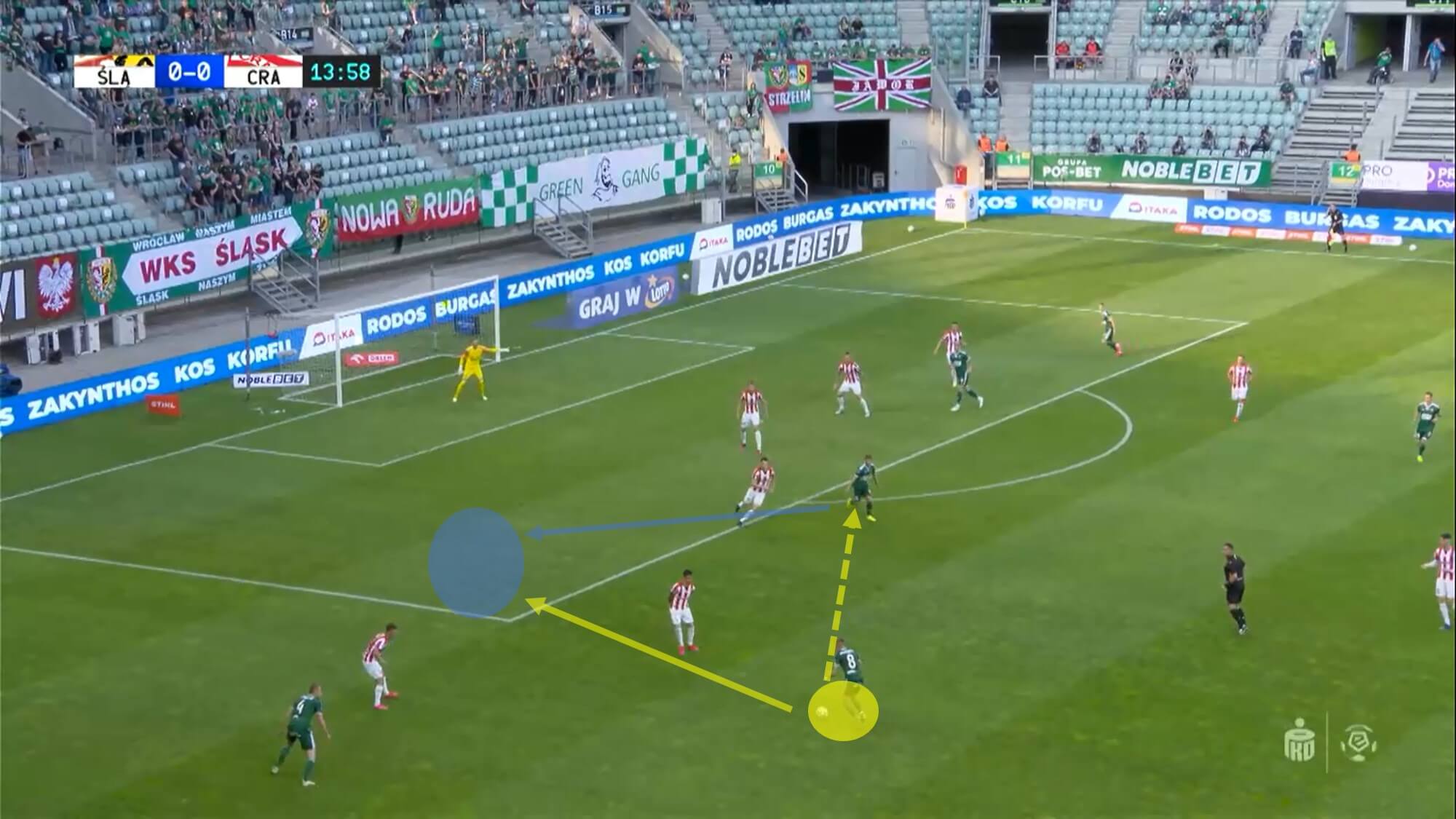
By doing this, he drags the right back out of the defensive line. Placheta looks for the quick one-two, and he received the ball back in behind the defence. So, as well as using his pace on the ball to get into promising positions, the Pole also looks to play quick combinations with teammates.
Expected assists (xA) are a good measure of how creative a player is. Although he only set up three goals last campaign, he registered 5.63 xA. That means based on the quality of chances he created, we’d have expected him to have claimed five or six assists.
The former Pogon Siedlce man also boasts a very good record in front of goal. He exceeded his expected goals (xG) value, scoring eight from a total of 6.94 xG. 42.11% of his efforts went on target, which was the seventh-highest in the division out of all wingers. He’s able to strike the ball purely with his left foot, often generating a lot of power through his laces. Below is a map of where all of his shots in the past calendar year have ended up.
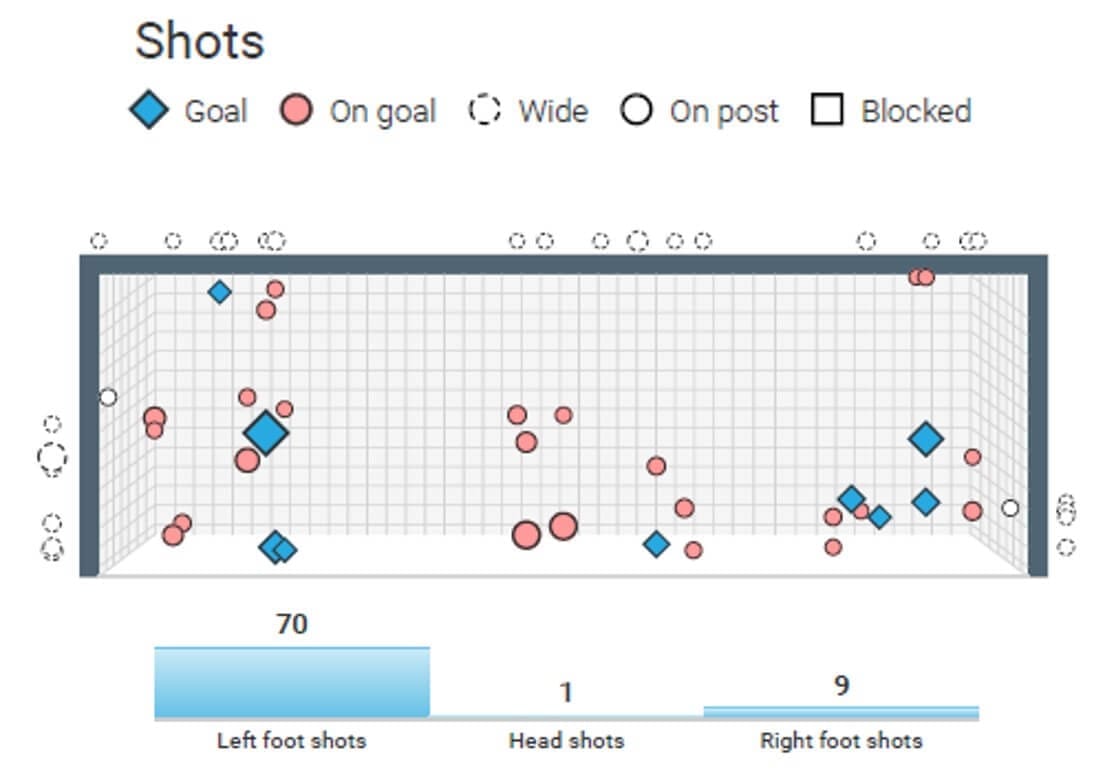
As you can see, he usually aims for the bottom corners, with only a small proportion of his efforts going towards the middle of the goal. Also, the vast majority of his goals were those strikes that were tucked into each bottom corner. It’s because of his quality in front of goal that Placheta isn’t afraid of shooting on sight. He hit an average of 2.13 shots per 90 minutes, which was the seventh most out of all wingers in the Ekstraklasa.
How will he fit in at Norwich City?
It’ll be interesting to see whether Placheta goes straight into the Norwich team, and where he plays. Currently, it’s hard to see him starting, as Emiliano Buendia, Todd Cantwell and Onel Hernandez are still Norwich players. However, Buendia and Cantwell have been heavily linked with moves away. If the talented pair do leave, then he’ll probably be thrown into the action from the start.
Both Placheta and Hernandez are capable of playing down either flank, so we could see them swap during games to keep opposing full-backs guessing. Norwich’s system and tactics should suit Placheta very well. If he plays on his favoured left-hand side, he’ll be able to operate in the half-space and in central areas, as the left-back will provide natural width.
Currently, the attack-minded Jamal Lewis is the club’s first-choice left-back, but it seems likely that he’ll be on his way to Liverpool. However, they have a ready-made replacement in Sam McCallum, who helped guide Coventry City to the League One title last season. Norwich signed the 19-year-old in January, but loaned him back to the Sky Blues for the rest of the season. Coventry played a 3-4-2-1 system, with McCallum as a left wing-back, so he’s used to being relied on for width. Those two could complement each other well, as Placheta’s tendency to play in the half-space could free up space for McCallum on the overlap. The Polish winger could then play closer to Norwich’s central attacking midfielder (most likely Marco Stiepermann), meaning they could overload the area between the opposition’s defence and midfield. This would be a useful way of getting into areas to provide passes in behind for Teemu Pukki, who uses intelligent movement to get away from defenders.
Conclusion
Norwich’s whole recruitment drive has been based around signing young players for the future, but there’s no reason why Placheta can’t have a big impact next season. As someone who has already impressed at senior level, the former Polish youth international is certainly expected to play a big part in the first team at Carrow Road. His chances of being a first-choice starter or not will depend on who stays and who goes, but you’d fancy him to have a solid run of games at some point in the season regardless.






Comments